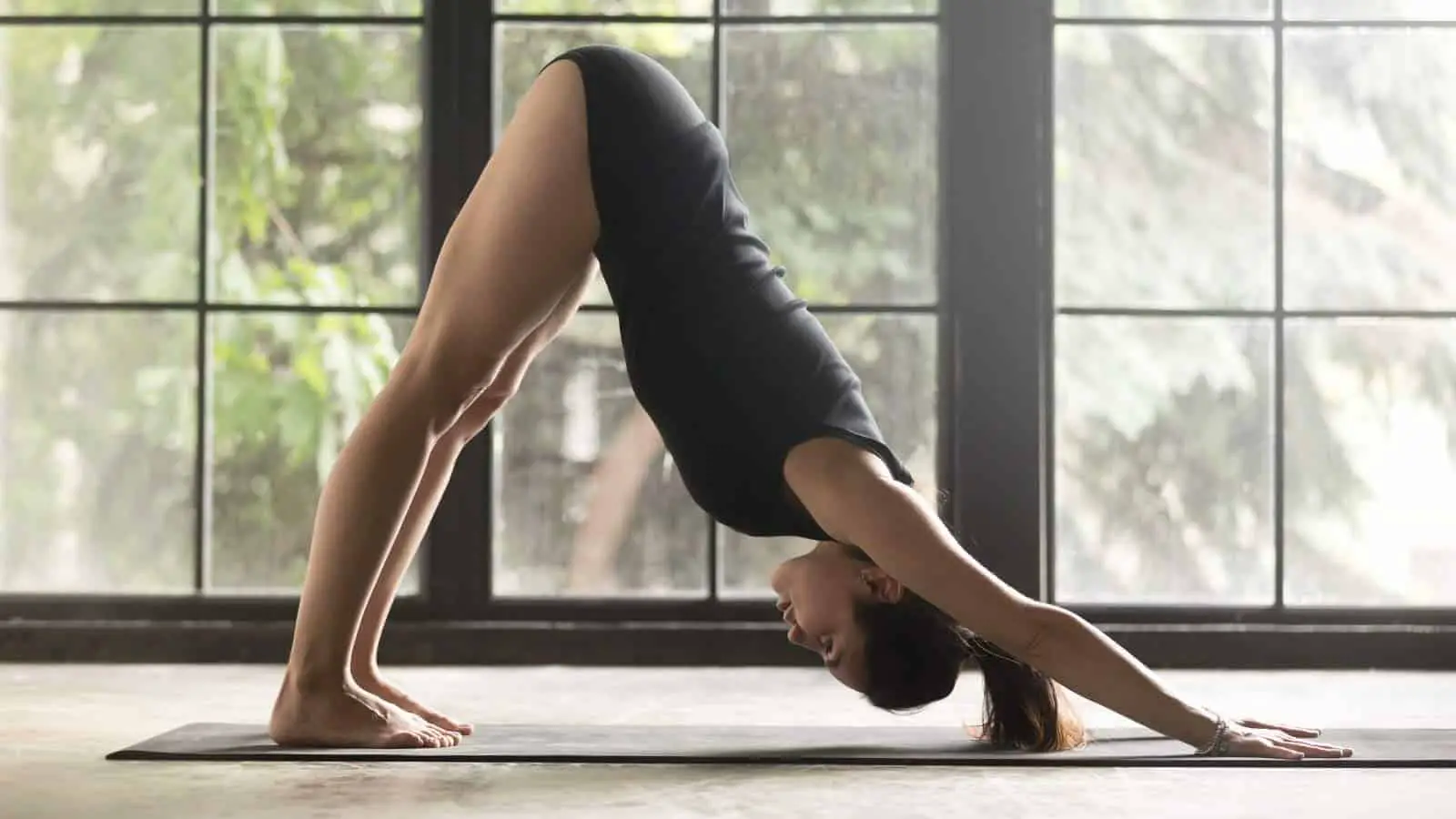Downward dog (Adho Mukha Shvanasana) is one of the most well-known yoga poses for good reason. The pose plays a role in almost all yoga routines and is one of the basic foundational moves of the practice. However, a downward dog may cause unwanted strain on the wrists for those new to yoga, resulting in pain.
In this article, we will discuss seven ways to alleviate pain when performing the downward dog move. These will cover various topics, from ways to modify the movement to improve your overall flexibility. Having good form in yoga is crucial to protecting your body and preventing injury.
Wrists hurt in Downward dog: Modify the Pose with Your Forearms
Modifying poses in yoga is a common practice and highly recommended for beginners and other practitioners unfamiliar with the poses, lack a right center of balance, or lack flexibility. Modified yoga poses can also be more relaxing and low energy for those recovering from an injury or simply wanting a calmer flow.
A common way to modify a downward dog that still provides a good stretch for the legs is by placing the forearms, rather than the hands, flat on the ground. This moves the wrists’ weight to the upper arms and elbows and is excellent for eliminating strain or pressure on fragile wrists.
Dolphin Pose
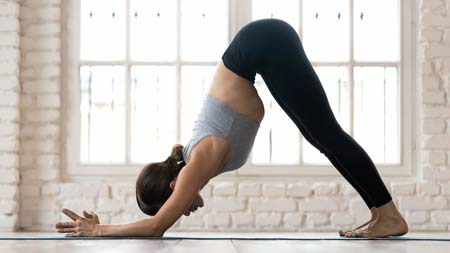
A downward dog where the forearms are placed flat on the ground rather than the hands actually is its own pose, known as the dolphin pose (Ardha Pincha Mayurasana). It is highly recommended as a temporary or permanent replacement of the downward dog pose for those suffering from carpal tunnel or other wrist conditions that cause weakness and pain.
To get into the dolphin pose, one should start from being on the hands and knees. The wrists should be directly beneath the shoulders before lowering the forearms to the ground, shifting the wrists’ pressure to the arms. The arms should be parallel to the side edges of the mat. From here, the knees can be lifted with the pelvis being pushed towards the ceiling. The knees can be straightened gradually and according to each individual’s skill level.
Additional Benefits
Each yoga pose is known for having its own set of benefits and ways to help the body’s physical health and alignment. There is a general misconception that modified yoga poses deprive the practitioner of a pose’s full benefits. However, modified poses can be just as helpful and beneficial as the original pose.
The dolphin pose helps to strengthen the shoulders, arms, upper back, and legs. This pose also helps with the flexibility of the body parts engaged in the move, such as spine, calves, and hamstrings.
If Downward Dog is Uncomfortable, Try Using Props
If you have ever taken a beginner level yoga class, you have seen yoga props used to adjust and modify poses. Even in advanced classes, some practitioners may use props to assist with certain moves if they have injuries or medical conditions that weaken their body’s specific parts or areas.
In truth, props are essential for many people to help build strength, balance, and flexibility in their yoga practice. Bodies that are not used to moving or stretching in the ways that yoga requires are at a much higher risk for injury, hence why a downward dog can cause varying amounts of pain in the wrist. The body may not yet have the right center of balance or strength to perform the move correctly.
Thus, props can help improve wrist pain and prevent injury in the downward dog pose. While the goal for many may be to remove the props, for some, using props eventually can become a regular part of their yoga practice.
Types of Props
Props are super popular and have only grown in popularity as yoga has become more widespread. There are several different types of yoga props with a variety of uses. Knowing which prop is appropriate for which situation is essential for using them correctly. The five main types of yoga props are block, bolsters, blankets, straps, and balls.
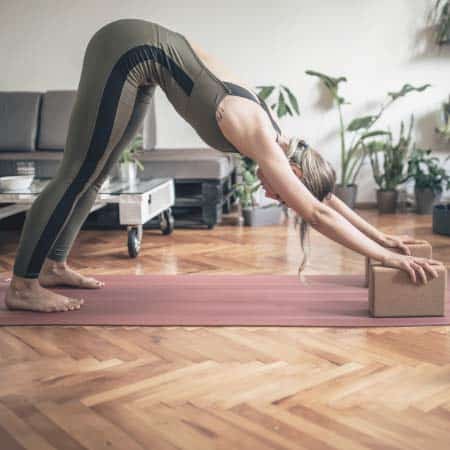
Blocks are typically in a three-dimensional rectangular form. They are most commonly made from cork and can have varying levels of firmness. They are excellent at assisting with balance and making stretches less intense. Blocks are the best prop to use to modify downward dog.
Bolsters are longer, cushion-like objects that resemble pillows and generally have a medium level of firmness. They are typically used to expand the body and achieve correct posture during practice.
Blankets are generally using during the final relaxation pose, Savasana, to help the body feel comfortable and centered. Blankets can also be folded and used for a similar purpose as bolsters.
Straps are generally used to assist in flexibility training. They help to stabilize the limbs and joints as they are being stretched. Inflexible body parts may shake when they are being stretched, but straps can help minimize this and ease tension.
Balls help to build core strength and balance. They also lessen pressure or tension when used to modify backbend poses.
Shift Your Weight to Limit Wrist Pain
A major issue causing pain in the wrists during downward dog could be too much weight being placed on the wrists during the pose. In truth, the weight should be mainly towards the back, with most of the pressure on the hips and legs. Beginners or those who are less flexible are likely to put too much weight forward onto the wrists by accident.
Shifting the weight backward has a lot to do with being conscious of one’s own balance and strength. It may be hard to notice at first that you are putting all the weight of your body forward onto your wrists. Chances are your wrists will be relatively weak unless you have built up wrist strength through yoga or weight training.
Comparatively, the hips and legs of a body can handle a lot more weight than the wrists. This is why you want the weight to be shifted backward in that direction. When this happens, most of the pressure causing pain in the wrists should disappear. The wrists then act more as a means of balance rather than a source of strength.
Tight Hamstrings
Tight hamstrings are often a significant cause of too much weight being shifted forward onto the wrists. There is a certain level of flexibility required to put the weight on the legs in the downward dog position. This pose puts a decent amount of strain on the hamstrings. An excellent way to tell if you have correctly shifted your weight off your wrists is if you feel more of a pull in the hamstring.
The flexibility of the hamstring can be improved over time. It may not immediately be easy for you to shift that weight onto the legs if your hamstrings are highly inflexible. That is why combining techniques, such as using the dolphin pose or using block props, can be extremely helpful while you improve your leg strength and hamstring flexibility.
Engage Your Fingers
Another way to help shift the weight off your wrists is to be conscious of what your fingers are doing. The fingers are certainly not very strong unless they have been trained to be. However, the fingers can help immensely with balance and supporting the wrists when adequately engaged.
Many people, beginners especially, will be more focused on the overall appearance of a pose. In truth, even little factors such as finger placement can significantly impact the ease and effectiveness of poses such as a downward dog. According to an article by Washington Post, placing more weight towards the thumb and index finger will result in less wrist pain than if the weight is focused more on the hand’s outer edge near the pinky.
Improve Your Flexibility to Keep Things in Line
As mentioned, flexibility likely plays a large role in the body’s ability to shift the weight away from the wrists during downward dog. While the flexibility of all body parts is essential for complete yoga practice, there are two main types of flexibility to consider when performing downward dog: leg and wrist flexibility.
Leg flexibility may be fairly obvious, thanks to the apparent tightness of the hamstrings and calves during downward dog. However, wrist flexibility is often overlooked. It is important to consider the range of motion your wrists are capable of. The wrists may be highly inflexible for those that work primarily on the computer, play video games, or do other activities that leave the wrists in one position for long periods of time.
In a downward dog, the wrists are bent at an angle, which might not be comfortable for the person who is not a regular yoga practitioner. This, combined with the added weight and pressure from the pose, can lead to the wrist pain you may be experiencing.
Leg Flexibility
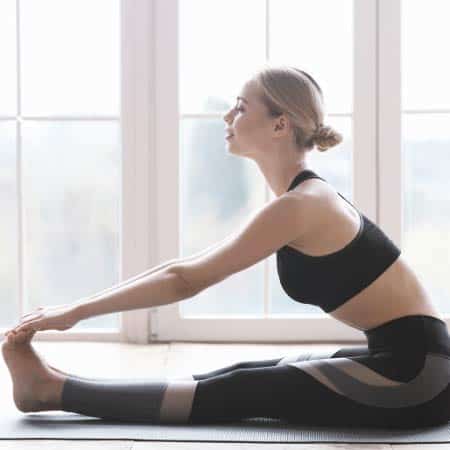
Those who want to improve leg and hamstring flexibility are advised to stretch the legs daily outside of a normal yoga routine or class. Stretching the legs in front of you in a sitting position and then reaching for the toes is a common stretch used to improve leg and back flexibility. In fact, according to GMB Fitness, improving back, hip, and calf flexibility will actually help with hamstring flexibility as well.
It is essential to listen to your body and improve your leg flexibility gradually. It would help if you only stretched until you begin first to feel the strain. Pushing yourself past this limit too early can easily lead to injury. Additionally, stretches should only be held for between 10 – 30 seconds to avoid unnecessary strain.
Wrist Flexibility
Practicing stretching your wrists daily will help with the downward dog pose and help alleviate the wrist tension that has built up over time. Many of us do not consider how our daily activities affect the wellness and overall mobility of our wrists. Typing, writing, and other hand-oriented activities all can contribute to a lack of flexibility and mobility.
To increase wrist flexibility, a common stretch is to outstretch one arm and bend the wrist so that the palm is facing outward. With the other hand, gently pull the bent wrist back towards you. This stretch should be done gently so that only slight strain is felt, as too much of a stretch may injure the fragile wrists. Another good stretch is joining the palms of the hands in a praying position and angling the arms to be parallel with the ground.
Bend Your Knees to Ease Strain on Joints
Bending your knees during downward dog is probably the most common modification to the pose. By bending the knees, the weight is almost automatically shifted back towards the hips and feet while lessening the strain on the hamstrings.
If doing a downward dog in the modified dolphin pose is too difficult, bending the knees is an equally acceptable modification. Additionally, bent knees can be paired with the dolphin pose while greater leg flexibility is still being improved upon.
It is important to remain conscious of your overall form even if you choose to modify the downward dog by bending the knees. The knees should bend straight out over the toes and should not angle inwards towards each other as this can cause unwanted strain on the legs and feet. When working up to straightening the knees, it is crucial to do so gradually so as not to cause injury.
Heels Don’t Have to Touch the Floor
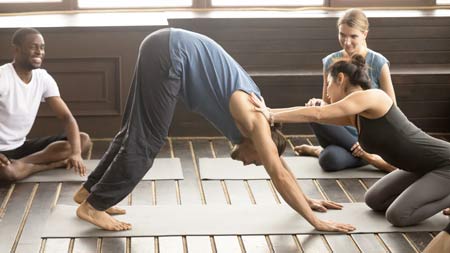
Another important factor to keep in mind is that your heels are not required to touch the floor during downward dog. While highly experienced yoga practitioners will likely have their entire foot touching the floor, getting the heels to the floor actually requires a decent amount of flexibility and practice.
Touching your heels to the floor while your knees are bent will be even more difficult. However, thinking about bringing your heels to the floor while your practice straightening your knees is actually a good way to maintain good form. For some people, touching the floor with the heels is just a matter of flexibility, while for others, it is a matter of genetics, so do not feel discouraged if your heels prove to be difficult.
Use a Thicker Mat for Extra Cushion
Wrist pain during downward dog is likely due to strength and flexibility problems. However, it may also be indicative of the surface on which you are practicing. If you are doing your poses on a thin yoga mat or no mat at all, the ground’s hard surface may be applying too much negative pressure and contributing to your wrist pain.
Using a thicker style yoga mat, you are providing a lot more support for the parts of your body that connect with the ground, such as your hands and wrists. According to REI, thicker mats are typically used for therapeutic and restorative practices. This makes them a super helpful choice for those struggling with pain from poses.
Balance Assistance
In addition to supporting the wrists, thicker mats can also provide balance assistance. Thinner mats require the person to be able to balance themselves and are used by those who have either mastered their balance or are working to improve their balance.
Thicker mats, comparatively, can be helpful to those who are focusing on improving their flexibility first. If your main goal is to alleviate wrist pain during a downward dog, using a thick mat to supplement your stability can be essential.
Visit a Physical Therapist for a Professional Opinion
If your wrist pain is consistent and persisting, it may be time to consider visiting a physical therapist. Conditions such as carpal tunnel can cause immense wrist pain and greatly affect your overall yoga practice. There may also be minor injuries that have occurred as a result of improper form during downward dog or other poses.
Visiting a physical therapist when pain arises is crucial for preventing further injury. A physical therapist will also know the best way to treat the pain, which may even include taking a break from yoga for a few weeks, depending on the severity.
Wrists hurt in Downward dog: Final Thoughts
It is crucial to always listen to your body when it is feeling pain. Pain in the wrists during a downward dog can indicate several issues, from an incorrect form that misplaces weight to a lack of strength and flexibility.
The pain can also be a sign of a greater injury or health issues and may require the attention of a medical professional. It is important to always improve your yoga form gradually rather than pushing your body too far and potentially causing more significant harm.

